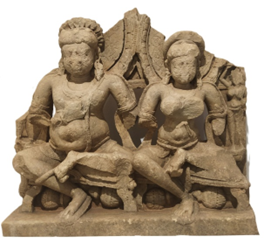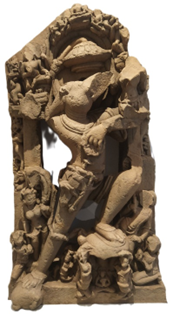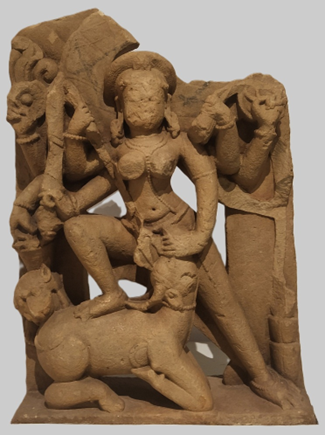संग्रहालय परिचय
वर्तमान संग्रहालय सन् 1961-62 में निर्मित पुराने जिला संग्रहालय के स्थान पर स्थित है, जिसे नये सिरे से विकसित एवं व्यवस्थित करने के लिए प्रदेश सरकार ने 18 सितम्बर, 2003 को भारतीय पुरातत्व सर्वेक्षण को हस्तान्तरित किया था। कालान्तर में पुराने संग्रहालय भवन को तोड़कर केन्द्रीय लोक निर्माण विभाग ने वर्ष 2009 में इस नये संग्रहालय भवन का निर्माण कराया और इसे 23 मई, 2011 को भारतीय पुरातत्व सर्वेक्षण को सौंपा गया।
पुरातत्व संग्रहालय शिवपुरी में 1755 पुरावशेषों का संग्रह हैं, जिनमें से 164 पुरावशेषों को प्रदर्शित किया है तथा शेष आरक्षित संकलन में संग्रहित हैं। ये पुरावशेषों मध्य प्रदेश के शिवपुरी जिला एवं इसके समीपवर्ती जिलों-मुरैना, दतिया, गुना एवं अशोकनगर से एकत्रित किये गये हैं, जो प्राग्-इतिहास काल से लेकर आधुनिक काल तक के है। ये पुरावशेष विविधतापूर्ण हैं, जिनमें प्राग्-इतिहासिक पाषाण उपकरण, ताम्र-निधियाँ, सिक्के, बन्दूक, तलवारें, उत्खनित सामग्री मुद्रांक तथा ब्राह्मण, जैन एवं बौद्ध-सम्प्रदायों से सम्बन्धित पाषाण प्रतिमाएँ प्रमुख हैं। यहाँ प्रदर्शित पुरावशेष प्रमुख रूप से शिवपुरी जिला के करोधा, नरवर, सेसई, पाली, कोटा, राजगढ़, गूडर, बलारपुर, तेरही, सुरवायागढ़ी, चोरपुरा एवं दतिया जिले के छोटी बड़ोनी नामक स्थान से प्राप्त हुये हैं। जैन प्रतिमा संग्रह में नरवर, पाली एवं गूडर से प्राप्त प्रतिमाओं की संख्या सर्वाधिक है। इनमें से नरवर से प्राप्त सफेद बलुआपत्थर से निर्मित मूर्तियाँ अपनी चमकदार पॉलिस से कारण अति विशिष्ट हैं।
वर्तमान संग्रहालय भवन में पाँच-वीथिकाएँ, सभागार, बहुकोणीय-लॉबी, दो-आँगन एवं कार्यालय कक्ष हैं। वर्तमान में तीन-वीथिकाएँ जनता के लिए खोली गयी हैं। इन तीन-वीथिकाओं में शिवपुरी जिले के कमानुसार इतिहास को संक्षेप में दिखाया गया है, जिनमें प्रथम-वीथिका का नाम 'अतीत के झरोखे से शिवपुरी', द्वितीय-वीथिका का नाम 'ब्ग्रह्मण एवं बौद्ध कला' एवं तीसरी-वीथिका का नाम 'जैन-कला' रखा गया है। वीथिका 1 में शिवपुरी जिले के इतिहास को प्रारम्भ से लेकर 1857 के प्रथम स्वतन्त्रता संग्राम तक संक्षिप्त रूप में दिखाया गया है। इस वीथिका का प्रवेशद्वार एक डायरोमा में खुलता है, जिसमें भारत एव शिवपुरी के प्राग्-इतिहास, आद्य ऐतिहास एवं इतिहास की जानकारी पाषाण-उपकरणों, ताम्र-उपकरणों, मूर्तियों, बन्दूक, तलवार, सिक्कों, राजाओं की वंशावलियों एवं चित्रों इत्यादि के माध्यम से दिखाने का प्रयास किया गया है। वीथिका के एक कोने में 1857 के प्रथम स्वतन्त्रता संग्राम' के नायक अमर शहीद तात्या टोपे की आवक्ष-प्रतिमा को प्रमुखता से प्रदर्शित किया गया है, जिन्हे अंग्रेजों ने सन् 1858 में शिवपुरी में फाँसी दे दी थी।
वीथिका-2 में ब्राह्मण एवं बौद्ध-कला को दिखाया गया है। इस वीथिका में सुरवायागढ़ी का प्रतिरूप, सुरवाया के उत्खनन से प्राप्त पुरावशेष, मूर्तियों जिसमें शिव परिवार, ध्यानस्थ लकुलीश, विष्णु के विभिन्न रूप, सूर्य, मातृकाएँ, मन्दिरों के द्वार भाग, बौद्ध-प्रतिमाओं में जाम्भल-वसुधरा एवं मुद्रांक इस वीथिका के मुख्य प्रदर्श हैं। इनमें से मत्तमयूर-शाखा के मुख्य केन्द्र सुरवायागढ़ी स्थित शैवमठ का प्रतिरूप प्रमुख है। इसके अतिरिक्त जाम्भल-वसुधरा की प्रतिमा एवं वृत्ताकार-पीठिका पर प्रदर्शित लघु-मन्दिर इस वीथिका का मुख्य आकर्षण है।
शिवपुरी जिले की जैन-कला एवं धरोहर को वीथिका-3 में प्रदर्शित किया गया है। इस वीथिका में मूतियों, जैन-दर्शन, कला, देवकुल, प्रतिमा-विज्ञान एवं विशेष आकार की पीठिका को दिखाया गया है। वीथिका का मुख्य आर्कषण एक वृत्ताकार-पीठिका है, जो जैन-ग्रंथों में वर्णित सुमेरू पर्वत से प्रेरित है। संग्रहालय में वीथिका के बाहर खुले आंगन के मध्य में संगमरमर की बाहुबली एवं मुख्य प्रवेशद्वार पर तीर्थकर की एक प्रतिमा भी स्थापित है।
About the Museum
The old district museum Shivpuri was constructed in 1961-62, located at the same spot where the present building was constructed later. The state government has handed over this old museum to Archaeological Survey of India (ASI) on 18th September, 2003 for better display and maintenance of the museum. Subsequently, the new building was constructed by CPWD in 2009 and it was handed over to ASI on 23th May, 2011 for establishing the museum.
The museum has a large collection of 1755 antiquities collected from Shivpuri and neigbouring districts- Morena, Datiya, Guna and Ashoknagar of Madhya Pradesh, which are datable from prehistoric time to modern period. The antiquities are diverse in nature, which include prehistoric tools, copper hoard, coins, guns, swords, excavated materials, sealings and sculptures of all major pantheons i.e. Brahmanical, Jain and Buddhist. Among the important sites from which these antiquities have been collected are Karotha, Narwar, Sesai, Pali, Kota, Rajgarh, Gudar, Balarpur, Terahi, Surwayagarhi, Chorpura in district Shivpuri and Chhoti Baroni in district Datiya, etc. The major collection of Jain sculptures belongs to Narwar, Pali and Gudar. Of these, Jain images of Narwar are special of its kind which are made of white sandstone and bearing lustrous polish. The total 164 numbers of antiquities and objects are displayed in the museum.
The museum has five galleries, conference hall, a pollygonal lobby, two courtyards and office, etc. Out of these, three galleries organized on the story telling theme, which are named as Gallery I-'Peeping into the past': Shivpuri, Gallery II – Brahhmanical and Buddhist Art and Gallery III- Jain Art. In the Gallery-1, the history of Shivpuri region is showcases beautifully with the help of diorama and panels which starts from prehistoric period and concludes with the First War of India's Independence in 1857. A diorama of rock-shelter conceptualized from rock-shelter at Churail Chhaj (Tunda Bharka Khoh) shows ancient man and his activities. The visitors can get a glimpse of prehistoric, protohistoric and historical cultures of India with the help of stone and copper implements, sculptures, guns, swords, coins and lineage charts of ruling dynasties, blowups, and portraits of Freedom Fighters. A beautiful bust of martyr Tatya Tope is displayed on a pedestal who was martyred in 1858 at Shivpuri.
This Gallery-2 highlights the Brahmanical and Buddhist art and architecture of district Shivpuri. The model of Surwayagarhi, excavated antiquities, sculptures of different forms of Siva, Lakulisha, Vishnu, Surya, mother goddesses, temple doorframes and the rare Buddhist sculpture of Jambhala-Vasudhara are main exhibits of the gallery. The model of Surwayagarhi, a famous monastery of Mattamayura sect of Shaivism is the centre of attraction in this gallery. Besides, Buddhist sealings are displayed in the small wall showcase and a doorframe of a temple fixed on the circular pedestal does attract the visitors.
The Gallery-3 displays Jain art and heritage of Shivpuri region. This gallery is designed on Jain philosophical theme which includes sculpture of Tirthankaras, informative panels & blow-ups showcasing Jain religion, philosophy, pantheon and special type of showcases. A special type of circular pedestal made on the concept of Sumeru Parvat of Jain mythology is of particular interest in this gallery. Besides, three Jain Tirthankaras displayed in a single showcase, sculptures of other Tirthankaras and a sculpture of Bahubali displayed in the centre of courtyard, are other attractions of the museum.
Master Pieces of Archaeological Museum Shivpuri
पुरातत्व संग्रहालय शिवपुरी के मुख्य पुरावशेष
जम्भल- वसुधारा

स्थानः सिलानगर, जिला शिवपुरी
कालः लगभग 11 वीं-12वीं शती. ईस्वी सामग्रीः बलुआपत्थर
मापः 102×104×26 सेमी.
पंजी.सं.: 1666
विवरण- जम्भल बौद्ध-देवकुल के सबसे प्रसिद्ध और समृद्धि के देवता माने जाते हैं। द्वि-भुजी जम्भल देवता अपनी शक्ति वसुधारा के साथ अलग-अलग आसन पर विराजमान हैं। यद्यपि यह प्रतिमा आंशिक रूप से खण्डित है परन्तु आध्यात्मिकता एवं परम्परा से पूर्ण है। जम्भल के दाहिने हाथ में सुरा-पात्र है तथा बायाँ हाथ खण्डित है। आसन के नीचे बने पात्रों से प्रतीत होता है कि ये धन की देवी एवं देवता हैं। देवता के दाएँ हाथ में जम्भल का लांछन कपाल है जो चषक जैसा प्रतीत होता है। आभूषणों से अलंकृत देवी वसुधारा जम्भल के बाएँ आसन पर बैठी हैं जिनके बाएँ पार्श्व में चाँवरधारी स्त्री खड़ी है। देवी के दोनो हाथ खण्डित हैं।
Jambhala-Vasudhara

Place: Silanagar, Distt.- Shivpuri
Period: Circa11th- 12th century CE
Material: Sandstone
Measurement: 102cm.×104cm.×26cm.
ACC. NO.-1666
Description-
Jambhala is one of ancient and most popular deity of prosperity in Buddhist pantheon, seated on two separate cushions with his consort Vasudhara. Though it is fragmented, but extent of image preserves the essence of beliefs and spirituality. Jambhala is holding a wine cup in his right hand while left hand is broken. The vessels underneath clearly show that they are the god and goddess of wealth. The right hand of the god has a kapala which is one of the indentifying features of Jambhala, though here the shape is more like a chalice. Bejeweled Vasudhara seated on the left of Jambhala accompanied by a chauri-bearer standing on her left. Her both arms are broken off.
नृ-वराह

स्थानः बैराड, जिला शिवपुरी
कालः लगभग 8वीं 9वीं शती. ईस्वी
सामग्रीः मोटा कणयुक्त बलुआपत्थर
मापः 180×89×35 सेमी.
पंजी.सं.:1363
विवरण-
चतुर्भुजी नृ-वराह की खण्डित प्रतिमा में देवता को प्रत्यालीढ़-मुद्रा में खड़े दिखाया गया है। इनका दायाँ पैर कछुआ के पीठ पर और बायाँ पैर सर्प फण पर टिका है जिसे दो सर्प नीचे से सहारा दे रहे हैं। देवता बाएँ कंधे पर देवी पृथ्वी को उठाए हुए उन्हें देख रहे हैं। उनके बाएँ निचले हाथ मे चक है और दाएँ दोनो हाथ खण्डित हैं।
यद्यपि यह प्रतिमा खण्डित है परन्तु देवता के पैर के दोनों पार्श्व में प्रदर्शित स्त्री आंतियाँ, नाग एवं उपासक स्पष्ट पहचाने जा सकते हैं प्रतिमा के दोनों ओर परिकर में व्याल, ऊपर पार्श्व में ब्रम्हा तथा विद्याधरों को दिखाया गया है। यह प्रतिमा तीन खण्डों में प्राप्त हुई थी, जिसे जोड़कर प्रदर्शित किया गया है।
Nri- Varaha

Place: Bairad, Distt.-Shivpuri
Period :Circa 8th-9th century CE
Material: Coarse grained sandstone
Measurement: 180 cm.× 89 cm.× 35 cm.
ACC. NO.-1363
Description-
A mutilated sculpture of four-armed Nri-Varaha is shown standing in pratyaleedha-mudra in which his left leg is placed over snake hood supported by two nagas. The right leg of the deity rests on a tortoise. He is carrying goddess Prithvi on his left shoulder and looking at her face. He is holding a chakra in the left lower hand while both right hands are broken.
Although the sculpture is mutilated, however several diminutive female figures, nagas, devotees shown near the leg are still identifiable. Brahma and flying vidyadharas on the top and vyala figures are depicted on either side as part of parikara. The sculpture was retrieved broken in three pieces but has been mended together for display.
महिषासुरमर्दिनी

स्थानः अज्ञात, जिला शिवपुरी
कालः लगभग 9वीं-10वीं शती. ईस्वी
सामग्रीः मोटा कणयुक्त बलुआपत्थर
मापः 180×89×36 सेमी. पंजी.सं.:1398
विवरण-
अष्टभुजी महिषासुरमर्दिनी को धमिल्ला प्रकार की केश सज्जा से शोभित, कुण्डल, भुजबन्ध और चूड़ियाँ के साथ प्रदर्शित किया गया हैं। देवी के दाएँ हाथों में चक, खड़ग, वाण को प्रत्यंचा पर चढ़ाने को तत्पर एवं त्रिशूल तथा बाएँ हाथ में घंटा, खेटक और धनुष लिए हैं। उनका दायाँ पैर महिषासुर राक्षस के ऊपर रखा है और बाएँ हाथ में महिष का मुख पकड़े हैं।
Mahishasuramardini

Place: Unknown, Distt.- Shivpuri
Period: Circa 9th- 10th century CE
Material: Coarse grained sandstone
Measurement: 180 cm.× 89 cm.×36cm.
ACC.NO.- 1398
Description-
The eight-armed image of Mahishasuramardini has a chignon headdress, large kundalas, bajubandha and bangles. Among the attributes are chakra, khadag, a quiver full of arrows and trisula in her right hands while in the left she holds a bell, khetak and bow. She rest her right leg on thebuffalo demon and with her left front arm grips the mouth of the animal.
नागराज

स्थानः अज्ञात, जिला शिवपुरी
कालः लगभग 9वीं-10वीं शती. ईस्वी
सामग्रीः बलुआपत्थर
मापः 179×59×29 सेमी.
पंजी.सं.: 1618
विवरण-
आंशिक रूप से खण्डित नागराज की इस विशिष्ट प्रतिमा का निर्माण अर्द्ध-गोलाई में किया गया है। नागराज जटामुकुट, कुण्डल, भुजबन्द, हार, कमरबन्द, पायल एवं यज्ञोपवीत धारण किए हैं। इनके ऊपर सर्पफण का छत्र एवं पीछे भाग में सर्प-वलय को दिखाया गया है। साँप की पूंछ का पिछला भाग सामने पीठ पर प्रदर्शित है। नागराज का बाँया हाथ नीचे की ओर और दाहिना हाथ ऊपर कंधे तक उठा है। ऐसा प्रतीत होता है कि यह नाग देवता की प्रतिमा है जिसे सभी देव लांक्षनों के साथ बनाया गया है। प्राचीन काल से ही इस क्षेत्र में नाग-पूजा का प्रचलन था, जो आज भी विभिन्न रूपों में प्रचलित है।
Nagaraja

Place: Unknown, Distt.- Shivpuri
Period: Circa 09th- 10th century CE
Material: Sandstone
Measurement: 179cm.×59cm.×29cm.
ACC. NO.-1618
Description-
Partly damaged but an unusual standing figure of Nagaraja carved in high relief, shown with matted hair wearing kundala, armlet, necklace, waist band, payal and long yagyopavita. He has canopy of snake-hoods and coiled body of snake is shown behind with looped tail end portrayed on the pedestal. His left hand is hanging down while right is raised up to the shoulder. It seems that it is an image of a Naga divinity shown with all attributes of divine figures. In ancient time naga worship was prevalent in this region and it was continued in later period in diverse forms.